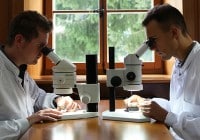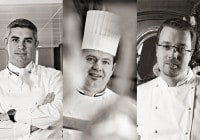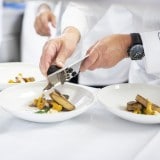
Search in Issues
Chapters
List of parts
Chapter 5
THE TRANSMISSION TIMES THREE
New chefs take charge at three of the world’s great restaurants
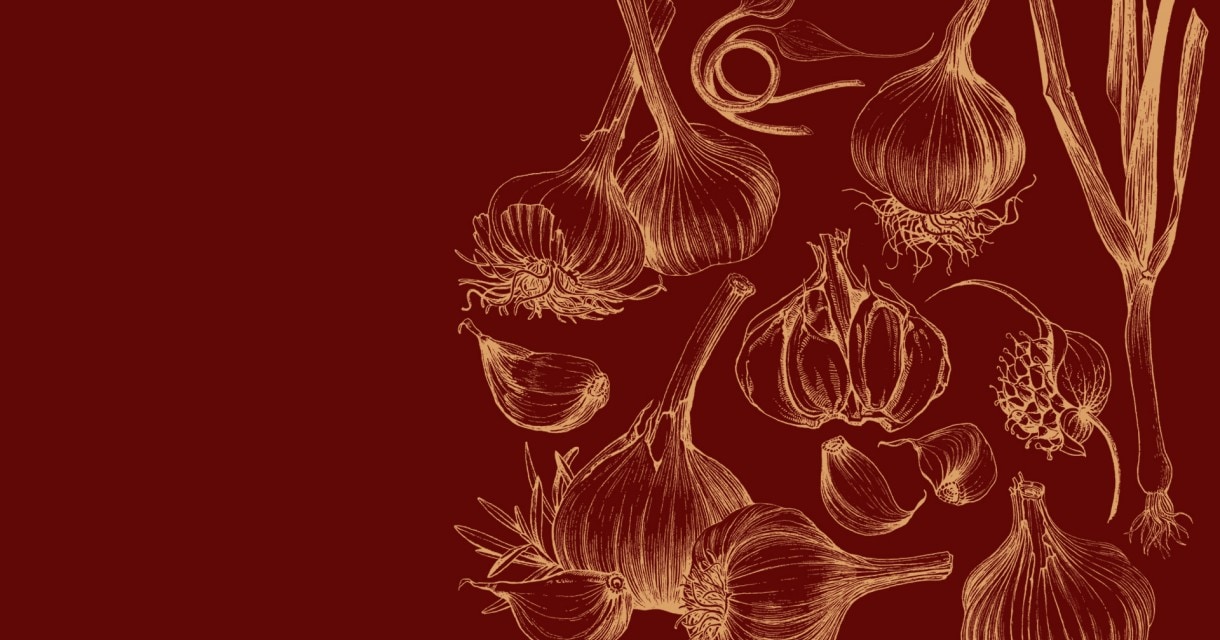
Ours is an epoch of change. More than celebrated and relished, it is the motor of our prosperity. Imagine the opposite; a freezing of time. Mainframes ruling the earth; not even a hint that there could be such a device as a mobile phone, much less a smart one; air travel reserved for only a privileged few; cameras requiring film; written correspondence via an envelope, paper and, god forbid, a stamp; music played on 33 rpm records. For most things we have reason to rejoice in the kind of progress that has pushed these venerable ways aside. But the list is not all embracing. Take for example three of the world’s most treasured and honored restaurants to which yours truly has been devoted for decades and which have been featured on these pages: Hotel de Ville in Crissier (Issue No. 1), Lameloise in Chagny (Issue No. 2), and Le Pont de Brent in Montreux (Issue No. 3).
For all three of these mighty icons the inspirational chefs who kindled the ardor which we reported in Lettres du Brassus and which the Michelin Guide seconded with their award of three stars year after year, have retired. Philippe Rochat to his mountain retreat in the Valais, Jacques Lameloise to his collection of classic cars, and Gérard Rabaey to his bicycle. That genre of change, far from being universally acclaimed often carries with it frissons. “What of the special spark from these departing grand chefs? What of that warm reassurance on every return visit that these masters were tending the stoves?”
That which has transpired is best captured by the French expression la transmission, the passing of the baton to a new generation. Now presiding in Crissier is Benoît Violier; in Chagny, Eric Pras; and in Montreux, Stéphane Décotterd. Can there be a more fundamental change for a restaurant than the installation of a new chef? So it falls to us to revisit each of these iconic institutions to update our reports. If you are given to flipping pages instantly to extract the conclusion or, perhaps, are blessed with staff who gin up daily news summaries, we will lighten the burden. For all three la transmission has been a resounding success and our recommendations remain undiminished in their enthusiasm. But that summary traverses the real genius of the transformation of the three restaurants. Each has confronted the daunting specter of both respecting the venerated history, style, and personality of the institution and allowing each of the new chefs to express his own creativity and ideas. Said another way each has sought to walk that fine line so as to soothe and reassure devoted clientele while at the same time tantalizing with innovation and evolution. How that balance has been found by chefs Violier, Pras and Décotterd is the real story.
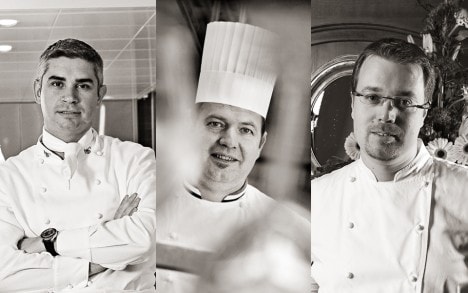
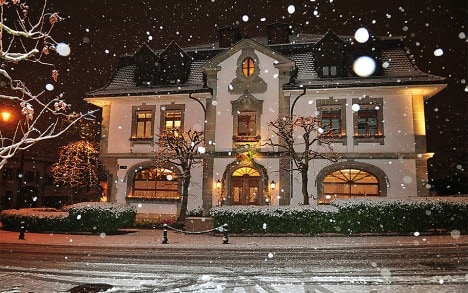
HOTEL DE VILLE, CRISSIER. BENOÎT VIOLIER.
Along the entry wall to the newly refurbished kitchen, gleaming with ultra-modern induction cooktops (and if you are a home cook lusting for professional equipment, set aside all notions of gas fired burners; the latest generation of induction burners offers higher power, quicker heating, and greater precision than gas), is a memorial to the successions, for there have been two, at Crissier. Lined up in linear fashion and shining against the slate gray wall are names “GirardetRochat-Violier”. Girardet is of course, Fredy Girardet, who founded the restaurant in 1971 and, on his way to earning the accolade as the finest chef in the world, created and defined modern Swiss cuisine.
The heritage of Crissier may be set out in a line, but there is an argument to be made for a circle as Benoît’s style seems to more closely evoke Girardet than Rochat. This is not to by any means suggest a radical departure as the differences are in nuance. During his brilliant tenure, Rochat’s cooking took on a degree of added complexity and incorporation of exotic Asian fl avors. Benoît has inclined more toward Girardet’s pioneering ethos with lighter, more straightforward preparations and banishment of the occasional Asian overtones.
In common with all three of the transmission chefs, Violier’s credentials confirm the wisdom of placing Crissier in his hands: five years as Nicolas Sarkozy’s chef during his tenure at the Ministry of finance in the early 90’s; pastry chef at famed Lenôtre in Paris; Joël Robuchon at Jamin; Alain Chapel in Mionnay (one of the early pillars of la nouvelle cuisine, a brilliant *** career cut short with his tragic death in 1990); arrival in Crissier in 1996 for Fredy Girardet’s last year; promotion to Philippe Rochat’s second in 1999; earning the award of Meilleur Ouvrier de France in 2000. Violier points to Chapel, Robuchon and Girardet as the strongest influences on his development; indeed, labeling his current style now as an “evolution of Chapel”.

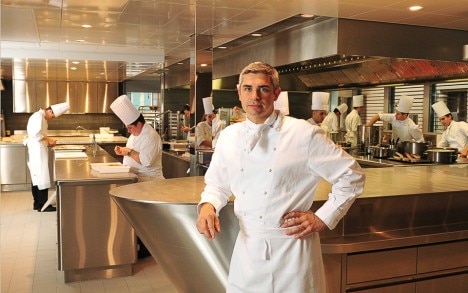
Paramount in his philosophy is respect for ingredients. Nothing is left to chance as he works personally with his suppliers both to insure that he is receiving the finest that they have to offer and to drive them even further to improve the quality of what they produce. That, of course, has been a guiding principle for the restaurant since its founding in 1971. There is a connection between his obsession with ingredients and the lightening and purification of his preparations. As Girardet pioneered with his removal of flour from sauces, Violier has radically reduced the use of cream and butter, turning instead to intensely flavored stocks (including vegetable and root stocks). Even a rich dessert preparation such as a chocolate genache has been transformed, removing the butter from the classic recipe and replacing it with highly concentrated milk. Seeing Asian spices as masking and standing in the way of the natural flavors of the key ingredients in a dish, they have been eliminated.
The intensity of Violier’s passion and the energy and drive he is bringing to Crissier is evidenced in what he has accomplished in just four months since taking over the restaurant. Of course he has conceived three entirely new menus, all bearing the stamp of his cooking philosophy. But soaring above that achievement, which alone would content those of high ambition, he has designed and presided over complete refurbishment of the dining rooms and garden. “Refurbishment” is somewhat of a limp term which communicates little of the scale of the redecoration and the excruciating devotion to detail that Violier has pursued in the transformation of the dining rooms. The color palate is now both brighter and warmer with blond woods and beige tones on the walls. Offsetting the woods and lending a touch of modernity and sleekness to the rooms are subtle brushed metal accents and slate gray carpeting. In place of flowers on each table are Baccarat bears, ducks, and penguins. Refined and understated serving tables echo the décor of the walls. Unseen is sound deadening which brings a calming tranquility to the room and computer controlled lighting that allows for individual adjustment of the illumination at each table. Outside, Violier has created terraces surrounded by a Japanese inspired garden.
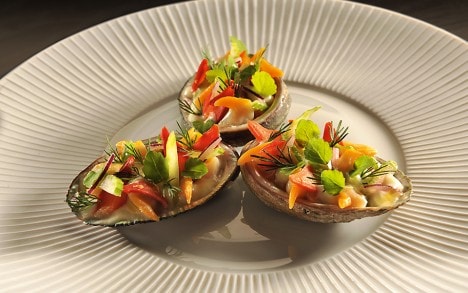
Ormeau.
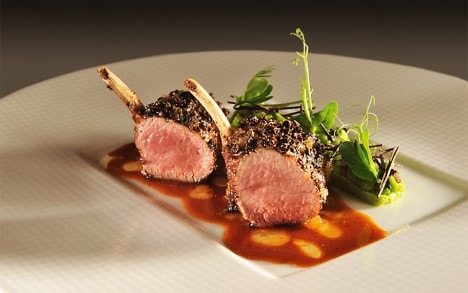
Côtes d’Agneau.
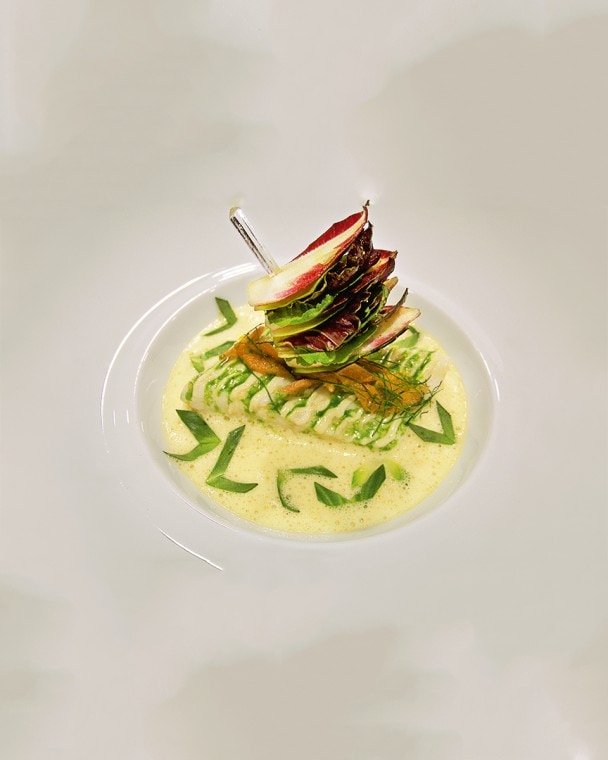
Tronçon de Saint-Pierre.
PURITY, LIGHTNESS AND SPARKLING FRESHNESS MARK VIOLIER’S CUISINE.
Three recent meals spotlight the purity, lightness and sparkling freshness of Violier’s cuisine. If a single dish could be put forward as demonstrating his philosophy, one would be tempted to nominate Minestrone iodé de Moules de Bouchots de la baie du Mont Saint-Michel “rafraîchies”. A radiantly bright red cold fresh tomato broth of otherworldly concentration and ripeness (Just how did he do that??? Plainly this was not a boiled reduction of tomato jus, as the flavor had no hint of cooking. What method was used to intensify flavor?) surrounds a mound of perfect shelled mussels, enlivened with a miniscule dice of crunchy vegetables, sophisticated by slivers of summer truffles. The genius of the preparation is its uncompromising intensity of flavor delivered with wondrous lightness and freshness. Or one might nominate Violier’s Œuf de poulette en chemise et Petits Légumes du moment cuisinés au jus de persil. This presented a poached egg encrusted with barely cooked sweet peas and a small dice of Jerusalem artichokes, poised on a bed of fresh peas, all bathed in an intense luminous parsley sauce. Sophisticated, light, fresh and intense. These are the adjectives that naturally pop to mind with his cuisine.
A brilliant starter from his second menu is Ormeau, Coques et Palourdes de la baie de Morlaix. Minimaliste intervention was the key to this dish featuring abalone and clams arrayed in the abalone shell, bathed in an impossibly light sauvignon sauce which served just to offset the natural sweetness of the shellfi sh. Similar deftness of touch showed in the following Gelées ravigotées de Crabe batailleur du Phare de Chassiron en Coque à l’Osciètre Impérial. Green crab from the Charente Maritime topped with a generous mound of oescettra was poised on an emulsion of shellfish stock accented by grapefruit. Violier’s sensitivity to nuance was displayed in every dimension. The agrume in the sauce offering just a polish of citrus, bits of fennel offsetting with sweet earthiness and crunch, caviar bringing salty contrast to the sweetness of the crab.
Warm fish preparations recalled the genius of Giradet as they translated classicism into a modern, light idiom. A stunning example is Violier’s Tronçon de Saint-Pierre de Porten-Bessin flashé, persillade au citron de Nice et petite salade amère. Cooked until barely translucent St. Pierre was enveloped in a rope of intense parsely puree, creating a Zebra-like appearance for the fish, both offset by a nearly luminous fish stock/citrus emulsion. Mesmerizing is the perfect description of the intensity and depth of flavor which Violier achieved. Similarly stunning is the Bar de ligne de La Pointe du Raz poêlé sur peau, Verjus de Féchy perlé à l'huile d’olive extra vierge. The bar is seared on the skin side, accompanied by a tempura of spring onion and zucchini flower, and sauced with a perfectly balanced reduction of verjus and fish stock, both accented by just a touch of remarkably fragrant olive oil. The key to the dish is the perfect harmony of the sweet fish and slightly acidic earthiness of the verjus reduction. Showing his fondness for textural contrast, the sauce offered small crunchy bits of fennel. Homard Bleu de Bretagne étuvé, réduction coralline à la Folle Blanche was at once classical and innovative. Tail and claw cooked to the perfect degree of translucence were accented by a classical shellfish stock, deepened by just a hint of the Folle Blanche Armagnac.
One of the grand traditions in Crissier is the tableside carving of fowl. And that tradition is doubly respected as Maitre d’Hotel Louis Villeneuve, a master of what the French call découpage and a longtime fixture in Crissier, continues to perform it along with his deft orchestration of the service in the dining room. If cooking fish until the flesh barely opens up as translucence arrives is a test of the precision of kitchen, so, too, is the roasting of fowl, particularly pintade. One minute too short and the guinea fowl arrives unappealingly bloody; one minute too long and it becomes equally unappealingly dry. Violier hit the mark perfectly with a magnificent dark bronzed bird presented first on a platter before Louis Villeneuve displayed his carving craft. The breast and sot-l'y-laisse were both enrichened by the sauce constructed with guinea fowl stock, a touch of veal stock (for added richness), bolet mushrooms and hint of thyme. One measure of the concentration of a wine is its length on the palate after swallowing. So, too, with a sauce. Violier’s was astonishing in its power, its essence lingering for well over a minute in the mouth. The second service of the leg and thigh respected a long tradition in Crissier, as the same intense sauce arrived with a decadently rich potato puree.
Violier’s lamb, Côtes d’Agneau des Alpes de HauteProvence poêlées au thym sauvage, on its own, merits a visit. Roasted with thyme, the rack is astonishing in two dimensions. First is the impossibly small diameter of the flesh and bones, plainly from a lamb who made his acquaintance with the butcher only a few days after entering the world. Second is texture. Of course the rules of restauration and polite table manners demand that a knife be set to accompany the plate, but there is no other reason. The meat is other worldly in its tenderness, the weight alone of the knife, no added pressure needed, serves perfectly to carve off the thyme accented morsels.
Desserts have been revisited to both lighten and intensify the flavors. The Bouchée de Pêche de vigne à la verveine is a case in point. A small tower of perfectly ripe pêche de vigne encased a lime zest flecked mousse of verbena. At the base was a puree of pêche de vigne. Plainly fascinated by texture contrast, Violier hid within the mousse small bits of almond and miniature croutons of sablé. Equally remarkable was the Croquants de Framboises, rafraîchis au citron Yuzu. The raspberries were miraculously enormous, almost recalling Woody Allen’s movie Sleeper where he knocks a guard unconscious with a giant strawberry. Each of the three crowned a small tart filled with a powerhouse raspberry gelee (and further underscoring Violier’s fondness for crunch, spikes of almond); served alongside was a parfait of yuzu, sprinkled with lime zest, raspberry gelee, and raspberry sorbet.
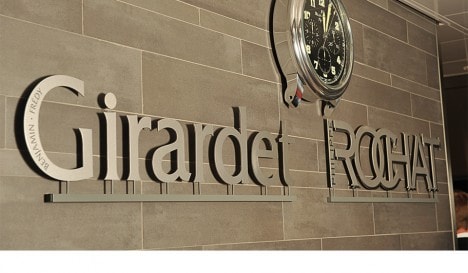
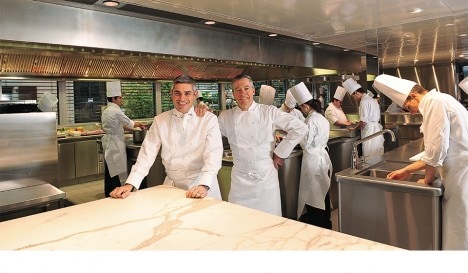
LAMELOISE, CHAGNY. ERIC PRAS.
Although Eric Pras’ three year overlap with Jacques Lameloise was shorter than that of Violier’s 15 years with Rochat or Décotterd’s 10 years with Rabaey, his resume before taking command rivals those of the other two. Like Violier he holds the coveted honor of Meilleur Ouvrier de France. Notable ports of call prior to his arrival at Lameloise in 2008 were Troisgros (during the period when both father Pierre and son Michel were working together, *** in Roanne), Le Buerehiesel with Antoine Westermann (*** in Strasbourg) and Régis and Jacques Marcon (*** in the Midi).
What is remarkable is that even at the outset, Jacques Lameloise was open to Eric’s innovations. One by one, celebrated classics were subtly refined. For example, La Tarte Fine aux Pommes avec Sorbet Granny Smith, which for decades has reigned on the dessert card as a reference point for apple tarts, was elevated to an even greater height with one studied modification by Pras. Formerly, the sorbet was served on the side, as it wouldn’t do to pose it directly on the warm surface of the tart. Pras’ solution: building a small mound of apple dice in the center both to place the sorbet on the tart and protect it from the heat below. Voilà, a subtle but effective revision.
The card at Lameloise is now a mixture of Pras’ original creations, plainly done with a deep understanding and appreciation of the restaurant’s traditions, and revisited classics, more the former than the latter. One of the enduring graces of the house is ordering and taking the aperitif in the salon, and only later settling in at the table. Of course a generous slab of amuse-bouches and accompaniments are part of the traditional ballad of a meal at Lameloise. Pras, has, however, completely reworked these appetizers. A recent meal featured, to name a few, a brilliant cherry tomato with an escargot parsley stuffing, marinated sardines with fresh goat cheese and zucchini, rolled smoked salmon with quinoa, and a remarkable “sandwich” of local saucisse, cornichon and butter. Although these appetizers vary with the season, there is one fixture which always dazzles with its ingenuity: escargot flavored popcorn.
There is one other tradition of sorts which is essential to the Lameloise experience, the extraordinary continuity of the wait staff. In the near quarter century that yours truly has visited, the Maitres d’Hotel (there are several each evening) have changed only slowly, and, even then, on the rarely occurring arrival of retirement. This carries over completely in the Pras era so that the habitués can be comforted and soothed seeing the same faces whose welcome and plain rejoice in the rhythms of the restaurant mark the occasion of every single Lameloise meal.
The amuse-bouches in the salon do not by any means displace those at the table. Pras displayed the deftness of his touch with a summer starter featuring cavaillon melon. Instead of pairing with ham, he found brighter fresher flavors by layering the thin melon slices on a base of local fresh goat cheese spiked with almost imperceptible dots of balsamic and herbs and a small shot glass of tarragon infused melon juice.
Appetizers, however satisfying, do not fully place on display the evolution of Lameloise’s cuisine under Pras’ stewardship. His Foie gras en robe de pomme de terre et chou en vapeur thoroughly demarks how he has respected the spirit of Jacques Lameloise but with an entirely new creation. Of course Lameloise has long offered warm foie gras preparations, but never before cooked en vapeur. Pras’ method achieves an ethereal texture as the foie gras nearly levitates off the plate and vaporizes on the palate. Accompanied by summer truffles and an intense truffle sauce the dish becomes transportive. Respecting the restaurant’s longstanding tradition of generosity, a small boat of the truffle sauce is always left at the table.

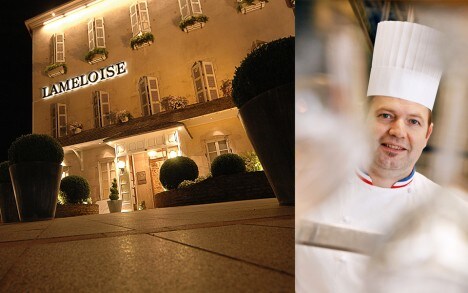
PRAS HAS REVISITED AND MODERNIZED THE CLASSICS AND INTRODUCED HIS OWN NEW CREATIONS RESPECTING THE RESTAURANT’S TRADITIONS.
Langoustines chaud & froid au jus de pomme verte, crème légère à la moutarde Fallot/caviar d’Aquitaine has cemented itself with a permanent place on the menu. Side by side are an immense langoustine with a crisped puff rice coating and a delicate langoustine tartare poised on a radiant pale green apple gelee. The refined acidity of the apple provides a perfect counterpoint to the tartare, particularly when offset with the caviar and extremely subtle mustard cream.
Turbot preparation has been reworked as well. Pras’ arrival in Chagny brought sous vide methods to the kitchen. An example is Turbot sauvage de nos côtes et couteaux , cuits en vapeur douce/rhubarbe, radis et mayonnaise chaude à la moutarde de verveine. Not only does the sous vide cooking bring millimetric precision to the preparation, the natural texture of the fish is fully preserved as it never is exposed to high heat. The earth, with the sweet rhubard, and the sea, with the sweet couteaux, play off each other, all moderated by the subtle warm mustard mayonnaise (actually more of a light sabayon than a mayonnaise), keeping both in check and marrying them with the turbot.
If the foie gras and turbot were entirely new creations, the Pigeon en vessie is a Lameloise classic completely re-imagined. Formerly the entire pigeon was cooked in the pigs bladder, together with a rich cream based foie gras sauce. Pras has modernized the dish, eliminating the cream and cooking only the breasts with a port and foie gras infused pigeon stock. The pigeons themselves perpetuate a longstanding relationship which Lameloise has with the Bresse producer Michon whose fowl are incomparable. Ensuring perfection in the cooking, Pras relies upon sous vide for much of the time. The perfectly rare breasts are served alongside small pasta towers encasing spinach and diced artichoke hearts and topped with finely minced truffle. Pras’ new conception delivers decadent pleasure with every morsel—ethereally tender pigeon, a majestic sauce, truffles propelled by the artichoke hearts. Even the thighs served separately are satisfyingly accompanied by a mixture of root vegetables.
The dessert card is combination of immutable standards and new creations. The devoted Burgundy wine clientele would take to the streets were Lameloise’s classic Crêpes Suzette flambées devant vous au Grand-Marnier glace vanille et chocolat to disappear from the menu. As advertised the crepes are finished tableside with the always entertaining fireworks. A new entry is the Pêche jaune sur l’idée d’une Melba. Although the construction is elaborate, this new creation delivers a perfect end of the meal punch. A succulently ripe peach half, glazed with gelee, is posed on a pain perdu base and filled with vanilla panna cotta. Under the base is an intense blood orange puree; poised on top, raspberry sorbet.
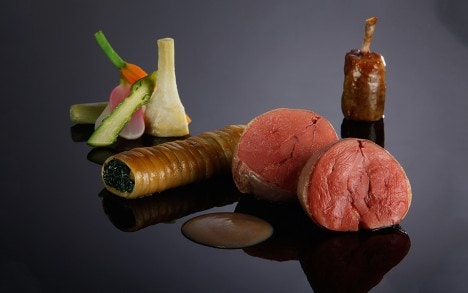
Pigeon en vessie.
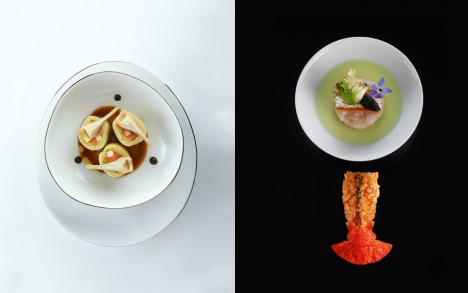
Foie gras en robe de pomme de terre, Langoustines chaud & froid.
LE PONT DE BRENT, MONTREUX. STÉPHANE DÉCOTTERD.
The road to taking the reins from an icon like Gérard Rabaey is never short. Stéphane Décotterd began his career at the famed Lausanne Palace Hotel. From there he moved but a few miles East to begin his career with Rabaey at Le Pont de Brent. Although he spent 10 full years under Rabaey’s tutelage, his tenure in Montreux was briefl y interrupted for a grand “road trip” adventure across North America. Following his return to Pont de Brent he won first prize as the best young chef in Switzerland (the Kadi d’Or in 2008) and earned fifth prize the following year in the French Bocuse d’Or competition in Lyon. Décotterd gained more than prizes and training in his decade before assuming command, he met his wife, Stéphanie, who was at the time the sommeliere at Pont de Brent.
As with the two others, he is intensely aware of the fine line he must tread—both to maintain the proud traditions of Rabaey and, yet, at the same time to allow his own creativity to take flight. He was particularly sensitive to the perils of radical change as Stéphanie worked in Strasbourg, home of the once famed restaurant Crocodile which failed following a too ambitious revision of the menu apparently alienating the faithful. So Décotterd has applied a deft and measured touch to the restaurant’s tradition, not that this forces an unnatural departure from his own philosophy, as he resolutely maintains that his cooking beliefs occupy common ground with Rabaey.
All the rhythms of Le Pont de Brent remain in full flight, as one settles at the table with the aperitif (highly recommended the champagne with pêche de vigne liquor), the weighty menu and wine decisions eased with a parade of irresistible appetizers. A recent selection offering a beignet de fromage (noteworthy for its depth of cheese flavor), tarte aux légumes, tourteau en feuilleté, gelée de lapin à l’estragon, and a croustillant de ris de veau au poireau.
Décotterd’s L’aile de raie aux légumes grecs demonstrates the dual imperatives of his own creativity and his faithfulness to Rabaey’s philosophy. Bright and fresh, a hallmark of Rabaey, this entirely new preparation paired the raie with a cresson sauce that was at once ethereal and intense.
Hinting at adventures that await as the restaurant evolves, was the following Vinaigrette de Homard au concombre et raifort. Normally I don’t naturally gravitate toward warm/cold combination preparations, but this one seduced in a way so as to banish whatever reflexive resistance that otherwise might have risen to the fore. Indeed, it was brilliant in all its dimensions. The warm half of the plate offered perfectly translucently cooked lobster, set on a bed of cucumber dice, and sauced below with a delicate vinaigrette dominated by the shellfish stock. Opposite were two “cannelloni” of cucumber stuffed with lobster tartare, and dollops of an elegant and subtle horseradish sauce. The fascination of the plate was the way in which a side ingredient, the cucumber, connected the two lobster preparations.
The studied refinement that Décotterd brings to the table was emphatically evidenced in his Soupe de Pétoncles et Coquillages au fenouil. Half of this dish recalled many of Rabaey’s fish preparations which he sauces with impossibly small delicate clams. Their presence in this dish, brought depth and presence to the sweetness of the petoncles, punctuated by small hits of caviar. But what really brought an extra measure of sophistication was the fennel infused emulsion that showcased the seafood.
An entirely new fish preparation is a tour de force, Le Filet de Rouget Barbet au Romarin, "Arancini di Maria" aux Supions. The centerpiece is, of course, red mullet, skin side seared to generate a crust, and the underside just warmed to firmness. There is a symphony of flavors as the Mediterranean tomatoes (the Arancini di Maria) are reduced to a powerful confit, blend naturally with the rosemary, and, as well the fish stock enrichened by the liver of the mullet, all to accent the perfectly cooked fish.
A signature of Pont de Brent for decades has been a preparation of sometimes frog legs, sometimes ris de veau, sometimes morels married with three other components: a rich veal stock, parsley, and a light foam.

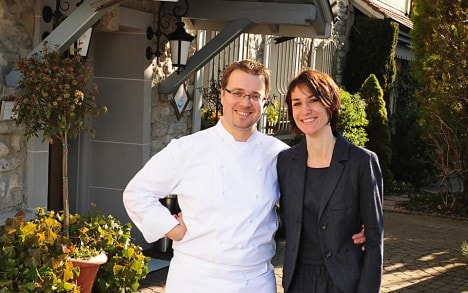
ALL THE RHYTHMS OF LE PONT DE BRENT REMAIN IN FULL FLIGHT.
That tradition carried forward perfectly with Morilles farcies au foie gras et aux asperges vertes. Another riff on the theme is Les Fleurs de Courgettes farcies aux Cuisses de Grenouilles, Roquette et Parmesan. Stuffed zucchini flowers are well tread ground. Not like this. Instead of stuffing with a deadening flavor—have we all had enough cheese filling?—Decotterd doubled the intensity with a small dice of zucchini, subtle herbs and deboned frog legs. The effect is transportive as the preparation builds layers of flavor and texture—zucchini (the flower and dice amplifying each other), rich veal stock, delicate meaty overtones of the plump frog leg morsels, the zing of peppery roquette, and the nearly transparent cheese providing just a salty overtone.
There is another Pont de Brent classic that Décotterd has not altered: whole roast duck, cooked perfectly rare and carved tableside. Only a handful of restaurants in the world have mastered whole roast duck, decandently rich and unimaginably tender. And that comes after the theater of watching the gleaming mahogany colored bird arrive at the table for carving (always drawing approving leers from diners at neighboring tables). Of course, there is the second service of the legs and thighs, accompanied here by a light salad dressed in walnut oil.
One element of the Pont de Brent ritual was revisited early on after Décotterd took charge, the cheese cart. Still impressive in its selections, the cheese now is exclusively sourced within Switzerland. Two ever present highlights are the long aged Gruyere caramel and the local Tomme de Rougement.
Even the small menu at Pont de Brent offers two desserts (not counting the petits fours and ending chocolates). Recent examples were mango three ways, an intense sorbet, a meringue with coconut accents and a riveting tarte tatin of mango. That mighty array was followed by a rhubarb tart flanked by vanilla ice cream and rhubarb sorbet.
Another evening presented La Pêche Jaune au Cœur fondant, en “Carpaccio” et sorbet. A peach lovers dream. No less than an essence of peach three ways, inventively layered into a unified whole. Building from the bottom were the carpaccio of succulently perfect peach, a nut encrusted cylinder of peach sorbet, bearing on top a white chocolate ball filled with peach mousse and dice of fresh peach. Altogether this was a brilliant expression of summer. The use of white chocolate was particularly clever as it added sweetness and complexity without upstaging the peach.
It is gratifying that all three restaurants have navigated the challenges of change of chef with such élan. Our wholehearted endorsement for all three remains undiminished in its fervor. Hotel de Ville, Lameloise, and Le Pont de Brent all stand out as three of the finest restaurants in the world.
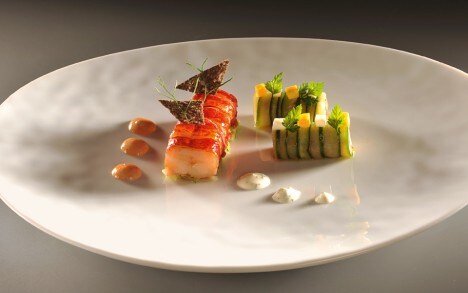
Vinaigrette de Homard.

Filet de Rouget Barbet.
Other issues
Don't miss the latest issue
Sign Up for New Releases


